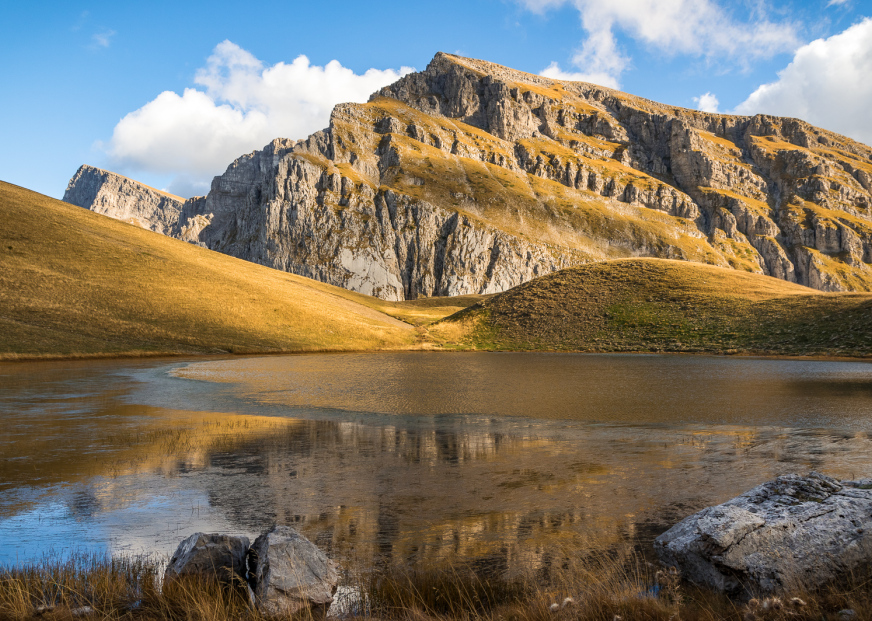3 MIN
TRAVEL TIPS
Zagori

 As the snow starts to melt from the peaks and highlands of Mt. Tymfi, it supplies the rivers and streams of the lowlands. The water, thanks to its inexhaustible force, has been digging through the limestone in the course of millions of years forming marvels like Vikos—the deepest gorge in relevance to its width in the world and the majestic Dragon lake—a tarn on Mt. Tymfi that was excavated by a glacier.
As the snow starts to melt from the peaks and highlands of Mt. Tymfi, it supplies the rivers and streams of the lowlands. The water, thanks to its inexhaustible force, has been digging through the limestone in the course of millions of years forming marvels like Vikos—the deepest gorge in relevance to its width in the world and the majestic Dragon lake—a tarn on Mt. Tymfi that was excavated by a glacier.
 This vast grid of rivers and streams is also the reason why this once wealthy region had a long tradition in the making of stone bridges. These magnificent arched structures were built from master craftsmen who used mostly experience and instincts rather than science to build them and connect Zagoria—as all the villages are collectively called—with the outside world. From a hundred and sixty bridges, today less than a hundred survive. The most iconic being the three arched bridge of Plakidas (aka Kalgeriko).
This vast grid of rivers and streams is also the reason why this once wealthy region had a long tradition in the making of stone bridges. These magnificent arched structures were built from master craftsmen who used mostly experience and instincts rather than science to build them and connect Zagoria—as all the villages are collectively called—with the outside world. From a hundred and sixty bridges, today less than a hundred survive. The most iconic being the three arched bridge of Plakidas (aka Kalgeriko).
 Being part of North Pindos National Park has helped Zagori to stay away from touristic overgrowth, thus keeping its isolated character relative intact. At the same time, it can provide high standard accommodation in beautiful small hotels and guest houses and an exquisite cuisine using fresh and all natural local ingredients.
Being part of North Pindos National Park has helped Zagori to stay away from touristic overgrowth, thus keeping its isolated character relative intact. At the same time, it can provide high standard accommodation in beautiful small hotels and guest houses and an exquisite cuisine using fresh and all natural local ingredients.
 It is one of the most complete adventure destinations in Greece, offering a wide array of trails as well as mountaineering and rock climbing routes through its amazing and diverse landscapes formed of gorges, virgin forests and mighty peaks. Rafting and kayaking are two more popular activities for which people gather to Zagori and especially river Voidomatis.
It is one of the most complete adventure destinations in Greece, offering a wide array of trails as well as mountaineering and rock climbing routes through its amazing and diverse landscapes formed of gorges, virgin forests and mighty peaks. Rafting and kayaking are two more popular activities for which people gather to Zagori and especially river Voidomatis.
 From all the villages of the region, Tsepelovo is the biggest with a population of near three hundred people. Some of the villages have less than ten people during winter and some are not even inhabited. The weather is fair from spring to autumn even though Epirus is the rainiest part of Greece. Winters can be heavy and sometimes the villages are cut out for brief periods of time.
The closest city to Zagori is Ioannina—the capital of Epirus and a beautiful destination by itself. It has an airport but unfortunately, international flights are rather limited. Thessaloniki—the second biggest city in Greece, is 5 hours by car.
Chrisostomos Kamberis
Photographer/Content Creator
Trip & Trail
Facebook
Twitter
Pinterest
Instagram
From all the villages of the region, Tsepelovo is the biggest with a population of near three hundred people. Some of the villages have less than ten people during winter and some are not even inhabited. The weather is fair from spring to autumn even though Epirus is the rainiest part of Greece. Winters can be heavy and sometimes the villages are cut out for brief periods of time.
The closest city to Zagori is Ioannina—the capital of Epirus and a beautiful destination by itself. It has an airport but unfortunately, international flights are rather limited. Thessaloniki—the second biggest city in Greece, is 5 hours by car.
Chrisostomos Kamberis
Photographer/Content Creator
Trip & Trail
Facebook
Twitter
Pinterest
Instagram


